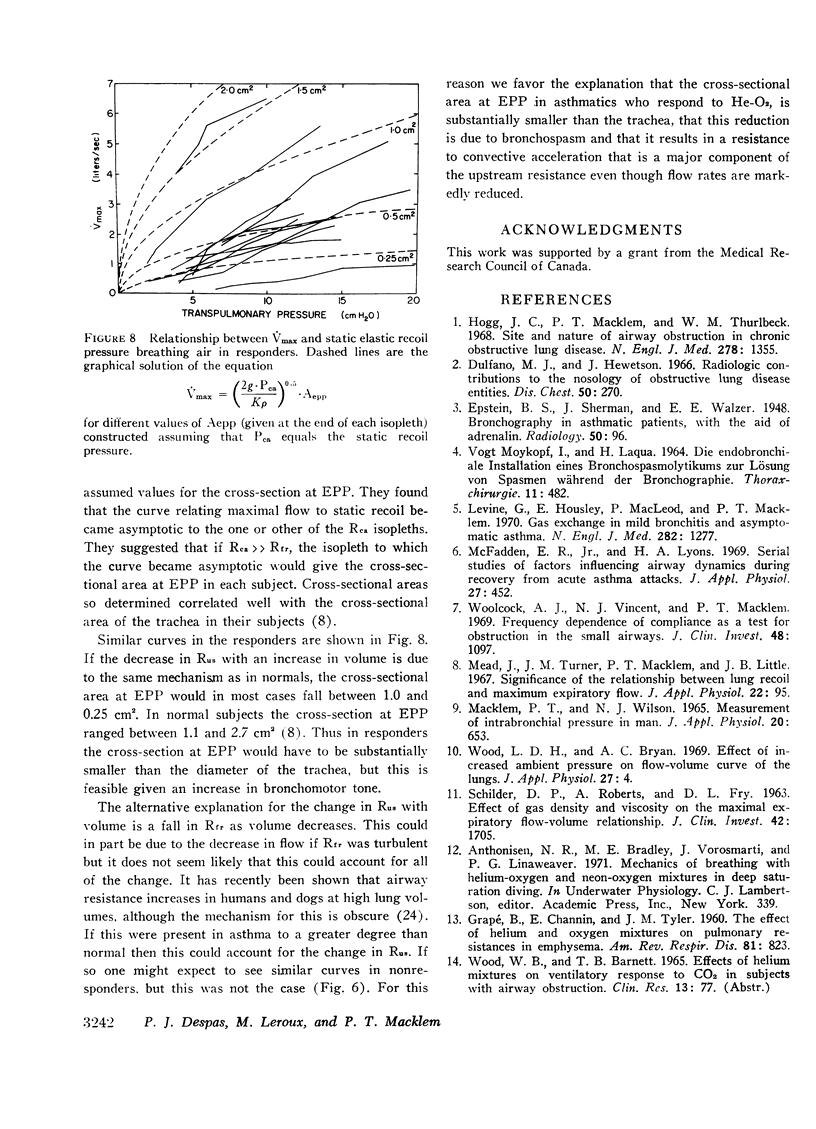Abstract
Because maximum expiratory flow-volume rates in normal subjects are dependent on gas density, the resistance between alveoli and the point at which dynamic compression begins (Rus) is mostly due to convective acceleration and turbulence. We measured maximum expiratory flow-volume (MEFV) curves in asthmatics and chronic bronchitics breathing air and He-O2. In the latter and in some asthmatics, MEFV curves did not change, indicating that Rus is mostly due to laminar flow. Therefore, the point at which dynamic compression begins must be further upstream than in normal subjects and the site of obstruction must be in small airways. In other asthmatics, flow increased normally indicating obstruction in larger airways. The response to He-O2 did not correlate with initial values of pulmonary resistance, the initial MEFV curves or the response to bronchodilators. We conclude that the site of airway obstruction varies among asthmatics and that the site of obstruction is not detectable by measurement of the usual parameters of lung mechanics.
Full text
PDF








Selected References
These references are in PubMed. This may not be the complete list of references from this article.
- Barnett T. B. Effects of helium and oxygen mixtures on pulmonary mechanics during airway constriction. J Appl Physiol. 1967 Apr;22(4):707–713. doi: 10.1152/jappl.1967.22.4.707. [DOI] [PubMed] [Google Scholar]
- Dulfano M. J., Hewetson J. Radiologic contributions to the nosology of obstructive lung disease entities. Dis Chest. 1966 Sep;50(3):270–280. doi: 10.1378/chest.50.3.270. [DOI] [PubMed] [Google Scholar]
- GRAPE B., CHANNIN E., TYLER J. M. The effect of helium and oxygen mixtures on pulmonary resistances in emphysema. Am Rev Respir Dis. 1960 Jun;81:823–829. doi: 10.1164/arrd.1960.81.6.823. [DOI] [PubMed] [Google Scholar]
- Hogg J. C., Macklem P. T., Thurlbeck W. M. Site and nature of airway obstruction in chronic obstructive lung disease. N Engl J Med. 1968 Jun 20;278(25):1355–1360. doi: 10.1056/NEJM196806202782501. [DOI] [PubMed] [Google Scholar]
- Levine G., Housley E., MacLeod P., Macklem P. T. Gas exchange abnormalities in mild bronchitis and asymptomatic asthma. N Engl J Med. 1970 Jun 4;282(23):1277–1282. doi: 10.1056/NEJM197006042822301. [DOI] [PubMed] [Google Scholar]
- MACKLEM P. T., FRASER R. G., BROWN W. G. BRONCHIAL PRESSURE MEASUREMENTS IN EMPHYSEMA AND BRONCHITIS. J Clin Invest. 1965 Jun;44:897–905. doi: 10.1172/JCI105206. [DOI] [PMC free article] [PubMed] [Google Scholar]
- Macklem P. T., Mead J. Factors determining maximum expiratory flow in dogs. J Appl Physiol. 1968 Aug;25(2):159–169. doi: 10.1152/jappl.1968.25.2.159. [DOI] [PubMed] [Google Scholar]
- Macklem P. T., Wilson N. J. Measurement of intrabronchial pressure in man. J Appl Physiol. 1965 Jul;20(4):653–663. doi: 10.1152/jappl.1965.20.4.653. [DOI] [PubMed] [Google Scholar]
- McFadden E. R., Jr, Lyons H. A. Serial studies of factors influencing airway dynamics during recovery from acute asthma attacks. J Appl Physiol. 1969 Oct;27(4):452–459. doi: 10.1152/jappl.1969.27.4.452. [DOI] [PubMed] [Google Scholar]
- Mead J., Turner J. M., Macklem P. T., Little J. B. Significance of the relationship between lung recoil and maximum expiratory flow. J Appl Physiol. 1967 Jan;22(1):95–108. doi: 10.1152/jappl.1967.22.1.95. [DOI] [PubMed] [Google Scholar]
- Olsen C. R., Stevens A. E., McIlroy M. B. Rigidity of tracheae and bronchi during muscular constriction. J Appl Physiol. 1967 Jul;23(1):27–34. doi: 10.1152/jappl.1967.23.1.27. [DOI] [PubMed] [Google Scholar]
- SCHILDER D. P., ROBERTS A., FRY D. L. EFFECT OF GAS DENSITY AND VISCOSITY ON THE MAXIMAL EXPIRATORY FLOW-VOLUME RELATIONSHIP. J Clin Invest. 1963 Nov;42:1705–1713. doi: 10.1172/JCI104856. [DOI] [PMC free article] [PubMed] [Google Scholar]
- VOGT-MOYKOPF I., LAQUA H. DIE ENDOBRONCHIALE INSTILLATION EINES BRONCHOSPASMOLYTIKUMS ZUR LOESUNG VON SPASMEN WAEHREND DER BRONCHOGRAPHIE. Thoraxchir Vask Chir. 1964 Feb;11:482–489. [PubMed] [Google Scholar]
- Vincent N. J., Knudson R., Leith D. E., Macklem P. T., Mead J. Factors influencing pulmonary resistance. J Appl Physiol. 1970 Aug;29(2):236–243. doi: 10.1152/jappl.1970.29.2.236. [DOI] [PubMed] [Google Scholar]
- Wood L. D., Bryan A. C. Effect of increased ambient pressure on flow-volume curve of the lung. J Appl Physiol. 1969 Jul;27(1):4–8. doi: 10.1152/jappl.1969.27.1.4. [DOI] [PubMed] [Google Scholar]
- Woolcock A. J., Vincent N. J., Macklem P. T. Frequency dependence of compliance as a test for obstruction in the small airways. J Clin Invest. 1969 Jun;48(6):1097–1106. doi: 10.1172/JCI106066. [DOI] [PMC free article] [PubMed] [Google Scholar]


